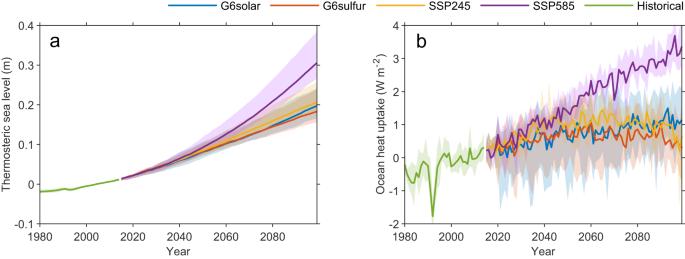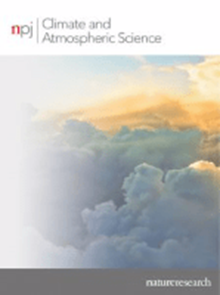太阳地球工程下的热阻和动态海平面
IF 8.5
1区 地球科学
Q1 METEOROLOGY & ATMOSPHERIC SCIENCES
引用次数: 0
摘要
IPCC 第六次评估报告预测,在 "一切照旧"(SSP585)的情况下,到 2100 年,沿海地区的海平面将比 1995-2014 年上升 2 米。地球工程可以减少这一威胁。我们利用五个地球系统模型模拟了两种不同的太阳地球工程方法(太阳暗化和平流层硫酸盐气溶胶注入),抵消了 SSP585 "无减缓 "情景和适度减缓 SSP245 温室气体情景之间的辐射强迫差异,分析了对全球平均热力和动态区域海平面的影响。到 2080-2099 年,与 SSP585 相比,两种形式的地球工程都能将全球平均热力海平面降低 36-41%(11.2-12.6 厘米),使 SSP585 条件下的全球平均可持续海平面上升与 SSP245 条件下的全球平均可持续海平面上升相一致,但并不能完全恢复区域可持续海平面上升模式。一些最大的减幅(∼18 厘米)出现在北美东部和日本人口稠密的海岸以及脆弱的北极沿岸永久冻土带。本文章由计算机程序翻译,如有差异,请以英文原文为准。

Thermosteric and dynamic sea level under solar geoengineering
The IPCC sixth assessment report forecasts sea level rise (SLR) of up to 2 m along coasts by 2100 relative to 1995–2014 following business as usual (SSP585) scenarios. Geoengineering may reduce this threat. We use five Earth System Models simulations of two different solar geoengineering methods (solar dimming and stratospheric sulfate aerosol injection), that offset radiative forcing differences between SSP585 “no-mitigation” and the modest mitigation SSP245 greenhouse gas scenarios, to analyze the impact on global mean thermosteric and dynamic regional sea levels. By 2080–2099, both forms of geoengineering reduce global mean thermosteric sea level by 36–41% (11.2–12.6 cm) relative to SSP585, bringing the global mean SLR under SSP585 in line with that under SSP245, but do not perfectly restore regional SLR patterns. Some of the largest reductions (∼18 cm) are on densely populated coasts of eastern Northern America and Japan and along vulnerable Arctic coastal permafrost.
求助全文
通过发布文献求助,成功后即可免费获取论文全文。
去求助
来源期刊

npj Climate and Atmospheric Science
Earth and Planetary Sciences-Atmospheric Science
CiteScore
8.80
自引率
3.30%
发文量
87
审稿时长
21 weeks
期刊介绍:
npj Climate and Atmospheric Science is an open-access journal encompassing the relevant physical, chemical, and biological aspects of atmospheric and climate science. The journal places particular emphasis on regional studies that unveil new insights into specific localities, including examinations of local atmospheric composition, such as aerosols.
The range of topics covered by the journal includes climate dynamics, climate variability, weather and climate prediction, climate change, ocean dynamics, weather extremes, air pollution, atmospheric chemistry (including aerosols), the hydrological cycle, and atmosphere–ocean and atmosphere–land interactions. The journal welcomes studies employing a diverse array of methods, including numerical and statistical modeling, the development and application of in situ observational techniques, remote sensing, and the development or evaluation of new reanalyses.
 求助内容:
求助内容: 应助结果提醒方式:
应助结果提醒方式:


